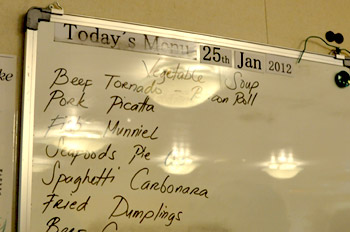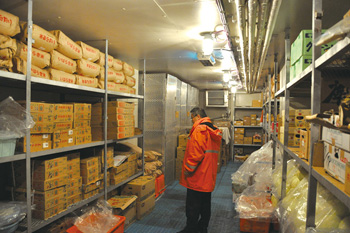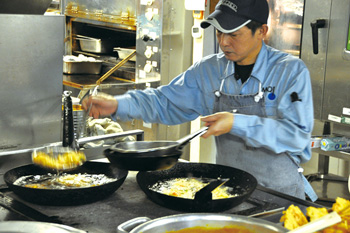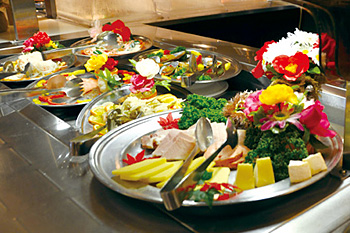
People of various nationalities, religions and occupations work on the CHIKYU. Meals for close to 200 people are prepared, and attention is also paid to a hygienic environment.
We talked to Chief Steward Mitsuo Sakai, whose work supports the research on-board.
(Published online March 2013)
| Interviewee: Mitsuo Sakai CHIKYU Chief Steward, Mantle Quest Japan Company Ltd. |
How many dishes can we cook from one ingredient?
Expeditions on the CHIKYU sometimes stretch over many months. We can say that the aspect most looked forward to when on board ship for such long periods of time is the food. “The food on the CHIKYU is delicious!,” agrees everybody who has sailed on the ship.
Chief Steward Mitsuo Sakai is the chief cook on the CHIKYU. A former head chef on cruise ship ASUKA, he has supervised meals on the CHIKYU from its maiden voyage.
Meals on the CHIKYU are organized on a four meal system basis. Since drilling continues for 24 hours a day, the restaurant is also open in the morning, afternoon, evening and night. Each of these times it is open for two hours, and food is served buffet style.
Says Chief Steward Mitsuo Sakai, “People from all over the world are gathered on the CHIKYU.” The menus consist therefore not only of Japanese food, but incorporate a variety of Japanese, Chinese and Western style food. Taking the example of bread, in Japan people prefer soft bread, but as there are also countries where firm bread is preferred that is provided too. On some days ramen (Chinese noodles), udon (Japanese noodles) and pasta are served. “Crew members are asked to report any dietary restrictions so that we know of these beforehand. Some people have things they can’t eat for religious reasons, others are vegetarian or have allergies. For that reason we are careful to display the ingredients we use,” explains Sakai. Rules regarding allergies are strictly observed in consultation with the nurse.
Despite these restrictions, care is taken so that the food isn’t boring. Meat dishes are for instance served for every meal, but Japanese people will tire of that. By continually changing the side dishes alongside the meat or fish there is a sense of change. The ingredients for meals for a maximum of 200 crew are only supplied once every two weeks, and purchasing costs for these are decided beforehand as well. “I think of a month’s worth of enticing menus, purchase the ingredients beforehand, and try and think of how many things we can cook with one ingredient. That is where our skills show.” (Sakai)
Buffet style meals are in fact difficult, as it goes to waste if too much is prepared. There is only a limited stock of ingredients on board. Everything is therefore prepared in advance, but the cooking is done while keeping an eye on how fast the dishes actually go. “We want people to be able to eat their hot meal while it is still hot.” For that reason two staff members are always present at the buffet to manage fresh supplies of food. The volume and timing of the food preparation is decided on the basis of estimations on how many people will want to eat at what time. This is where the skill comes in that only long years of experience can bring.
Sometimes food is served on only small serving plates, such as with French fries. Fresh supplies for these are brought out at short intervals, so that the food can be served freshly cooked. “The food on the CHIKYU is delicious!”: part of that secret lies in the meticulous care it is given.
- |1|
- 2|





